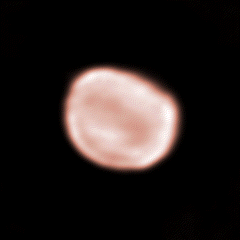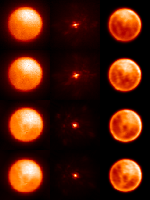

Vesta, one of the brightest main belt asteroids, as imaged with the Keck
Adaptive Optics system on its second night of operation. Images in three
bands (J=1.25 microns, H=1.65 microns and K' = 2.1 microns) were used to
produce a true color image. The open loop (no AO correction) image is shown
in the lower right hand side. The top row of images shows the results of
deconvolution (i.e., the estimate of the object which, when convolved by
the PSF - shown in the inset - most accurately reproduces the data). In
the true color image, red represents K; green, H; and blue, J. The albedo
at 1.2 microns is dominated by the reflection of pyroxene while at 2.1
mostly by that of olivine. Thus, a very blue area shows a concentration
of surface pyroxene, and red, a concentration of olivine.

This animated K band image is made of a series taken over a 20 minute interval. It is difficult to determine the rotation axis (Vesta rotates every 5.34 hours), because of the short sampling interval, so more data will be acquired during the next engineering run. However the fact that we can follow dark and light areas would seem to confirm the reality of the structures seen in the deconvolved images.

